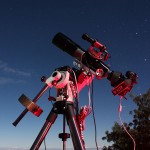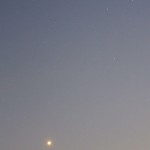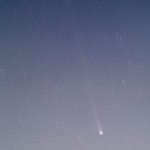While comet C/2012 S1 ISON is getting all of the attention, it is not the only comet currently visible. There are a couple other good comets available to observe or photograph. On Sunday morning I tracked down and photographed three comets.

Despite following comet ISON for the last year, I had never actually observed it myself. Attempts to change this repeatedly ran into problems, either work commitments or bad weather. Over the last month cloudy skies have been more common than clear, even the big ‘scopes on the mountain losing a large amount of time to poor conditions.
The forecast and satellite photos held out hope for Saturday night and Sunday morning, a promise of clear skies. Unfortunately the Moon was also full, this would create problems.
Thus I packed up the astrophoto rig, the iOptron mount, TV-76 and a pile of camera gear, departing for Hale Pohaku at midnight. All of the comets I hoped to photograph are dawn objects, arriving at HP at 1am allowed be time to setup and capture each comet as it rose over the horizon.

Still, I set the camera shooting, perhaps sheer quantity of frames would make up for the quality. With short exposures it would be easy to get a lot of exposures in the short time available.
Beside the moonlight the morning was glorious. The comets visible in the binoculars. There was almost no wind and the temperature was surprisingly warm. As dawn approached a few other comet watchers showed up.

Comet Encke was the last target, rising in the already bright glow of dawn just above the planet Mercury. I could be certain of the comet in the binocular field, I just set the telescope and camera on the right place and fired. Indeed there was a point of light in the correct position. There was only time for a few frames, so I set a short sequence of 10 second exposures and hit start.
When I first looked at the photos I despaired. How could I retrieve anything from the wash of moonlight? I could not bear to try for a couple days. Thursday I finally made the attempt, the signal to noise was horrible, but I has a lot of frames, 80 exposures on ISON and almost as many for Lovejoy.
It took several hours to process that many exposures. Fortunately much of that is automated, I can chose my settings and walk away from the computer for a while. In the end I managed a half decent photo of ISON, not the complete disaster I first feared. I have yet to process the Lovejoy image, at least this comet will still be high in the sky when the moonlight fades. Even Encke shows up faintly in the image, despite being so low in the glow of dawn.
This coming weekend offers another opportunity or perhaps later in the week. The moonlight is fading with the waning Moon, comet ISON is also brightening quickly. On the other hand the comet is rapidly getting lower in the dawn.

